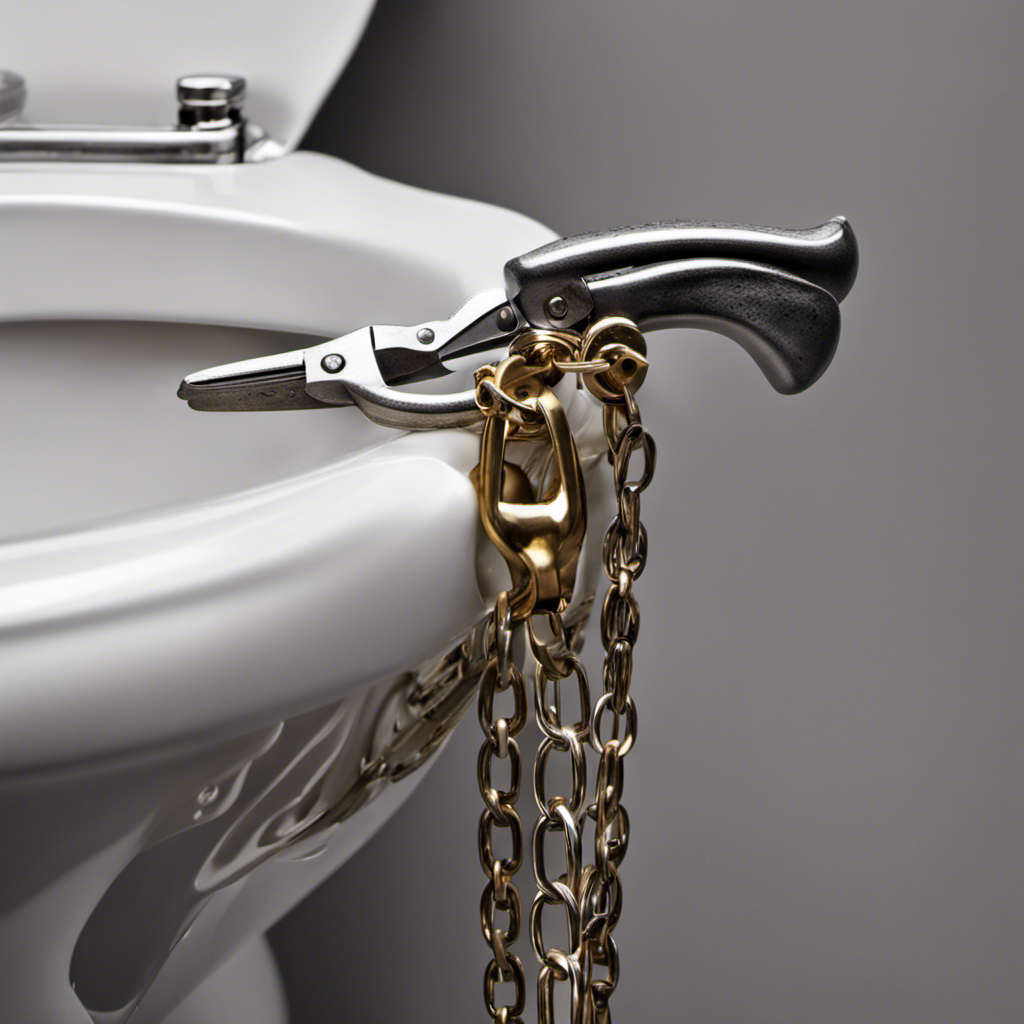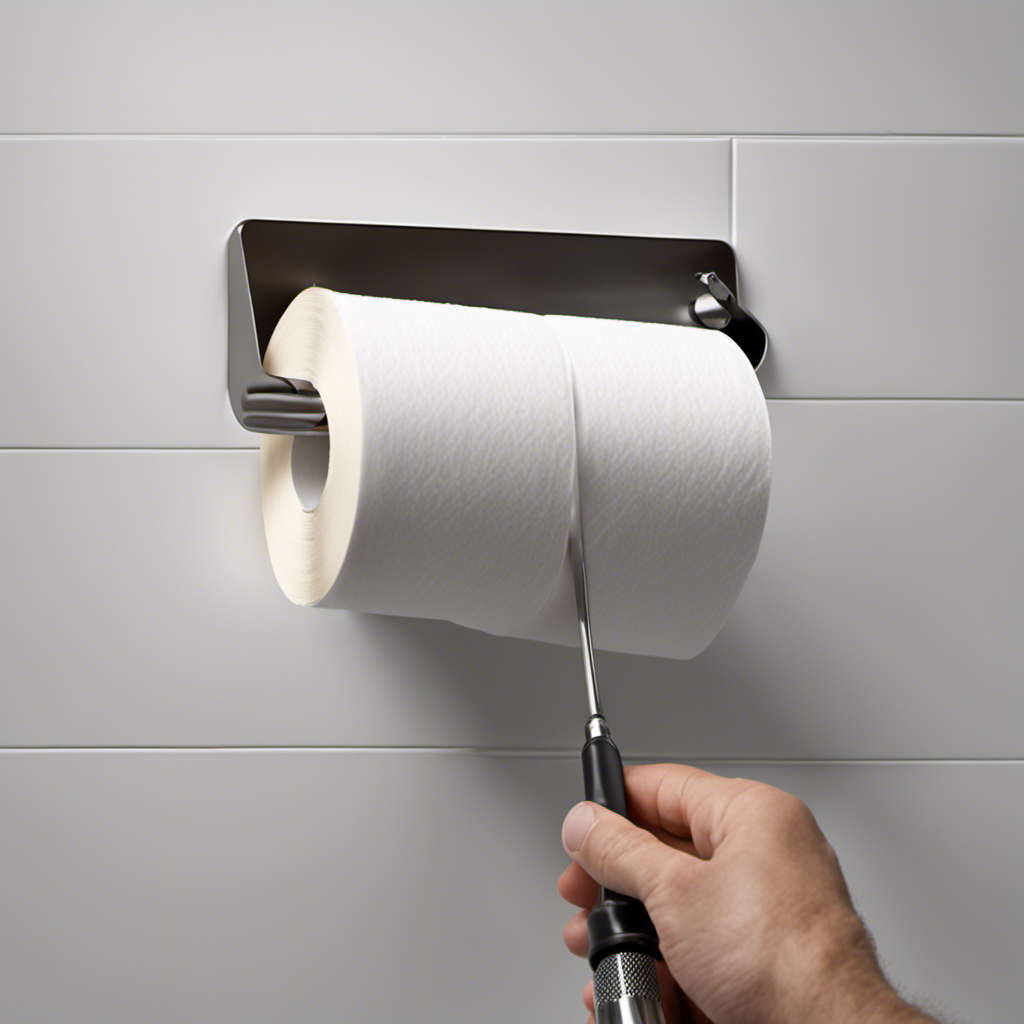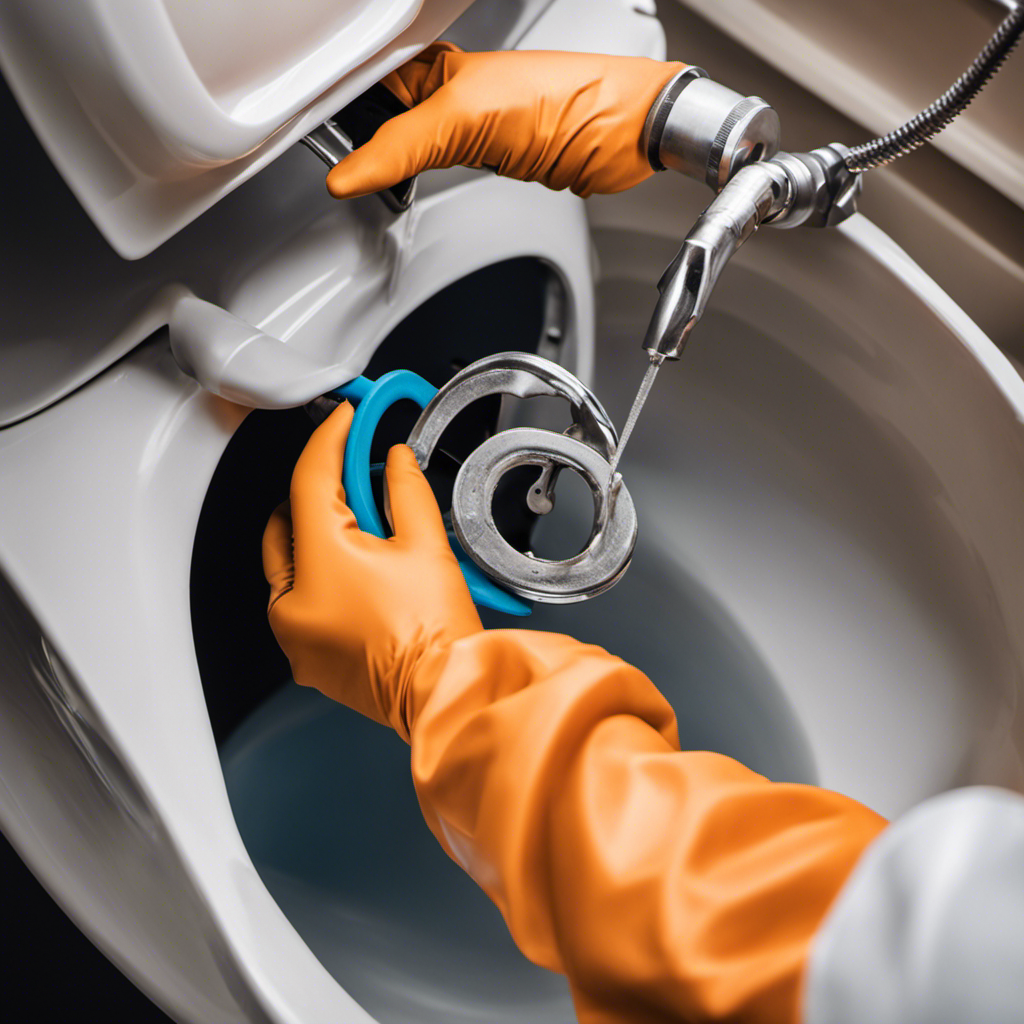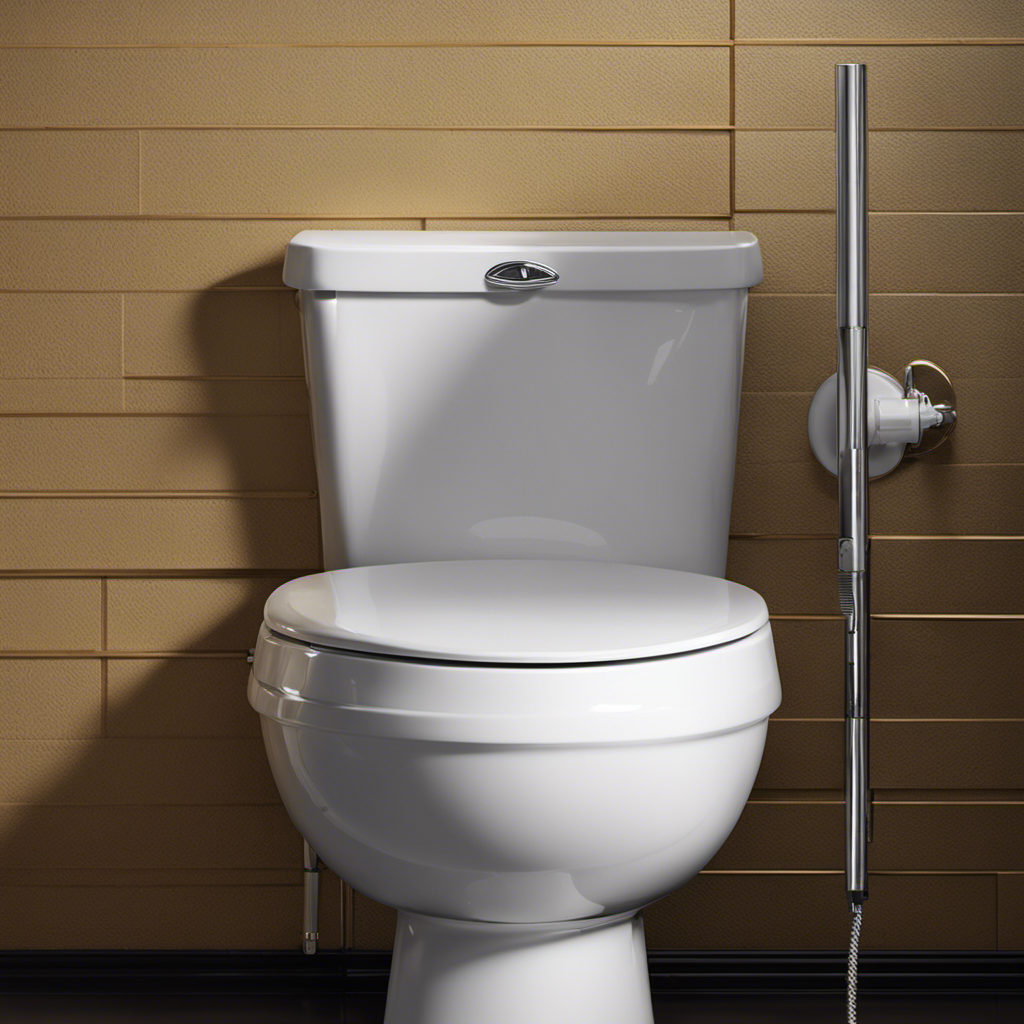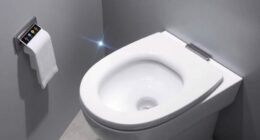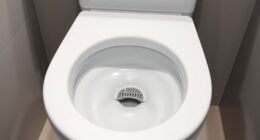Have you ever experienced the frustration of a toilet flapper that just won’t go down? It’s like trying to push a stubborn donkey through a narrow gate. But fear not, because I’ve got the solution for you.
In this article, I will guide you through the steps to fix a stubborn toilet flapper. We’ll identify the issue, inspect the flapper, adjust the chain length, clean or replace the flapper, check the water level, and adjust the float.
Let’s get that flapper back in line!
Key Takeaways
- A flapper stuck in the open position can be caused by mineral deposits or a misaligned chain.
- Troubleshoot by turning off the water supply and inspecting the flapper for cleaning or replacement.
- Ensure the chain is properly connected and adjust its length if necessary.
- Debris blocking the flapper’s movement can cause sealing issues, so clean the flapper and surrounding area to remove any buildup.
Identifying the Issue
If your toilet flapper won’t go down, it’s important to identify the issue before attempting any repairs. Troubleshooting common issues with toilet flappers can save you time and money.
One common problem is a flapper that is stuck in the open position. This can be caused by a buildup of mineral deposits or a misaligned chain. To fix this, first, turn off the water supply to the toilet. Then, remove the toilet tank lid and inspect the flapper.
Clean any mineral deposits with a brush or replace the flapper if necessary. Ensure that the chain is properly connected and adjust its length if needed.
Inspecting the Flapper
When it comes to the issue of a flapper not sealing properly, there are a few key points to consider.
First, it is important to check if the chain length is properly adjusted, as a chain that is too long or too short can prevent the flapper from sealing.
Additionally, debris blocking the movement of the flapper can also be a common cause of this problem.
Flapper Not Sealing
To fix a toilet flapper that won’t go down, check if you can feel any debris or mineral buildup on the flapper’s sealing surface. If there is debris or mineral buildup, it can prevent the flapper from sealing properly, causing water to continuously leak into the toilet bowl.
Here are some steps to address this issue:
- Turn off the water supply to the toilet.
- Remove the flapper by disconnecting it from the flush handle.
- Inspect the sealing surface of the flapper for any debris or mineral buildup.
- Use a soft brush or cloth to gently clean the surface.
- If the buildup is stubborn, soak the flapper in a mixture of vinegar and water for a few hours.
- Rinse the flapper thoroughly and reinstall it.
- Turn on the water supply and test the flapper to ensure it seals properly.
Regular flapper maintenance and replacement when necessary can help prevent issues like this from occurring.
Chain Length Adjustment
Adjusting the chain length can help ensure proper functioning of the flapper. If the chain is too tight, it can prevent the flapper from fully closing, leading to water leakage and an inefficient flush. On the other hand, if the chain is too loose, the flapper won’t seal properly, causing water to continuously run into the toilet bowl.
To adjust the chain tension, start by locating the chain connecting the flapper to the flush handle. Loosen or tighten the chain as needed, aiming for just enough slack to allow the flapper to close completely.
If adjusting the chain doesn’t solve the issue, there are alternative fixes to try. These include cleaning the flapper or replacing it altogether.
Debris Blocking Movement
If the chain is too tight, it can prevent the flapper from closing fully. Troubleshooting toilet flapper issues often involves checking for debris that may be blocking the movement of the flapper. Here are a couple of things to consider:
-
Types of toilet flappers:
-
Rubber flappers: These are the most common type and are prone to wear and tear over time.
-
Flapperless toilets: These use a valve instead of a flapper and are less prone to issues.
-
Debris blocking movement:
-
Check for any debris or mineral buildup around the flapper that may be obstructing its movement.
-
Clean the flapper and the surrounding area using a mild detergent or vinegar solution.
Adjusting the Chain Length
When it comes to proper chain adjustment for toilet flappers, there are a few key points to keep in mind.
First, it’s important to ensure that the chain is not too loose or too tight. A loose chain can lead to a weak flush, while a tight chain can prevent the flapper from fully closing.
Additionally, it’s crucial to avoid chain tangling, as this can prevent the flapper from functioning properly.
Proper Chain Adjustment
To ensure proper chain adjustment, make sure the flapper has enough slack to close fully but not so much that it gets tangled or caught. Here are some steps to follow for proper chain adjustment:
- Start by locating the chain connected to the flapper.
- Check if the chain is too tight or too loose.
- If the chain is too tight, it can prevent the flapper from closing properly. Loosen the chain by adjusting the length.
- If the chain is too loose, it can get tangled or caught, preventing the flapper from opening fully. Tighten the chain by adjusting the length.
- Test the chain length by flushing the toilet and observing the flapper’s movement.
- Make small adjustments to the chain length until the flapper closes fully without getting tangled or caught.
- Finally, ensure the chain has enough slack for smooth operation.
Proper chain maintenance and troubleshooting chain issues are essential for a well-functioning toilet.
Avoiding Chain Tangling
Avoiding chain tangling is important to ensure proper functioning of the toilet. When the chain gets tangled, it can prevent the flapper from closing properly, leading to continuous water flow and wastage. To troubleshoot flapper issues and prevent chain tangling, follow these steps:
-
Adjust chain length: Ensure that the chain is not too loose or too tight. A loose chain can get caught under the flapper, while a tight chain can prevent the flapper from closing fully.
-
Use a chain clip: Attach a chain clip to the flapper and chain to keep the chain in place and prevent tangling.
-
Check for obstructions: Inspect the chain and flapper for any debris or objects that may be causing interference. Remove any obstructions to allow smooth operation.
Cleaning or Replacing the Flapper
If your toilet flapper won’t go down, you can try cleaning it with vinegar and a brush. Cleaning the flapper is often a simple and effective solution to fix the issue without having to replace it. Here are some troubleshooting steps to help you:
-
Cleaning the flapper:
-
Turn off the water supply to the toilet.
-
Lift the lid of the toilet tank.
-
Locate the flapper and inspect it for any debris or mineral buildup.
-
Use a brush and vinegar to gently scrub the flapper and remove any residue.
-
Rinse the flapper with water and ensure it moves freely before reassembling.
-
Replacing the flapper:
-
If cleaning doesn’t resolve the issue, consider replacing the flapper.
-
Consult the toilet’s manual or seek professional help if needed.
Checking the Water Level
Check the water level in your toilet tank to ensure it is at the appropriate level for proper flushing. A correct water level is crucial for the toilet to function efficiently.
To determine if the water level is too high or too low, remove the tank lid and inspect the water level. If the water is too high, it could result in constant water flow and potential water leaks. On the other hand, if the water level is too low, it may lead to weak flushing power.
Adjusting the water flow can be done by adjusting the float, which controls the water level in the tank. By making small adjustments to the float, you can achieve the optimal water level for effective flushing.
Adjusting the Float
To adjust the float and achieve the optimal water level, simply turn the screw on the top of the float clockwise to raise it and counterclockwise to lower it. This adjustment is crucial for the proper functioning of your toilet.
Here are some common mistakes to avoid and troubleshooting tips to help you along the way:
-
Common Mistakes:
-
Not turning the screw enough or turning it too much.
-
Ignoring the water level indicator on the float.
-
Overlooking the importance of a properly adjusted float.
-
Troubleshooting Tips:
-
If the water level is too high, turn the screw counterclockwise to lower the float.
-
If the water level is too low, turn the screw clockwise to raise the float.
-
Make small adjustments and test the water level after each adjustment to ensure it is at the optimal level.
Seeking Professional Help if Necessary
When adjusting the float does not resolve the issue, it may be time to seek professional help. While DIY troubleshooting can often solve toilet flapper problems, there are instances where professional expertise is needed. A trained plumber can diagnose and fix more complex issues with the toilet flapper mechanism. They have the knowledge and experience to identify any underlying problems and provide the most effective solution. Seeking professional help ensures that the problem is addressed correctly, avoiding further damage or recurring issues. Here is a table illustrating the advantages of seeking professional help for toilet flapper problems:
| DIY Troubleshooting | Professional Help |
|---|---|
| Cost-effective | Expert diagnosis |
| Limited expertise | Efficient repairs |
| Time-consuming | Long-term solution |
Frequently Asked Questions
Can a Toilet Flapper That Won’t Go Down Cause a Toilet to Overflow?
A toilet flapper that won’t go down can potentially cause a toilet to overflow. However, there are alternative causes such as a clogged drain or a faulty fill valve. Regular maintenance can help prevent the flapper from getting stuck.
How Do I Know if the Chain Length Is the Cause of the Flapper Not Going Down?
To troubleshoot a toilet flapper not going down, I check if the chain length is the cause. I adjust the toilet flapper chain length by following the steps on how to adjust toilet flapper chain length.
Can a Dirty Flapper Prevent It From Going Down?
Yes, a dirty flapper can prevent it from going down. Cleaning the flapper and lubricating it can help it move freely. Remember, a clean flapper is a happy flapper, and a happy flapper means a functioning toilet.
Is It Possible to Fix a Flapper That Won’t Go Down Without Replacing It?
Yes, it is possible to fix a flapper that won’t go down without replacing it. Proper flapper maintenance and troubleshooting can help resolve the issue and restore normal functionality to the toilet.
Can Adjusting the Water Level Help With a Flapper That Won’t Go Down?
Adjusting the water level could potentially help troubleshoot a flapper that won’t go down. By ensuring the water level is at the proper height, it may assist in positioning the flapper correctly and resolving any issues.
Conclusion
In conclusion, fixing a toilet flapper that won’t go down requires identifying the issue and inspecting the flapper. Then, adjusting the chain length, cleaning or replacing the flapper, checking the water level, and adjusting the float.
It is important to address these steps systematically to ensure proper functioning of the toilet. A well-functioning flapper is the key to a smooth-running toilet, so don’t let this issue go down the drain! Take action and fix it today to avoid any future headaches.
